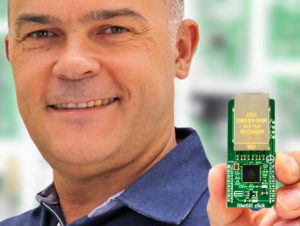
Click boards are used to add interfaces to microcontroller development boards – the company created its accompanying 16pin mikroBus standard ten years ago.
Mikroe now releases a new Click board nearly every day at 10am, according to the company: “and many companies now include the mikroBUS socket on their development boards, including Microchip, NXP, Infineon, Dialog, STM, Analog Devices, Renesas, Toshiba, Future Electronics and Avnet”.
“Why spend two months in development when you could pay under $50 for a ready-made solution which will enable you to develop your code and prove the concept?” said Mikroe CEO Nebojsa Matic, pictured with EtherCAT Click.
EtherCAT Click is centred on Microchip’s LAN9252 EtherCAT controller which has dual Ethernet PHYs – each PHY containing a 100Mbit/s full-duplex 100BASE-TX transceiver. It supports HP Auto-MDIX, allowing the use of direct connect or cross-over cables. Communication with the MCU host board is via synchronous SPI or SQI (high-speed SPI). Applications are foreseen in industrial control and factory automation.
The mikroBus socket has a pair of eight-pin headers on opposite sides of a rectangle centred 22.86mm (0.9in) apart, with connections for: SPI (4 pins), UART (2), I2C (2), PWM, interrupt, analogue, reset, +3.3V, 5V and ground (2).
Click boards are 25.4mm wide (1in) and come in three lengths: 28.6, 42.9 or 57.15mm, called S, M and L respectively.